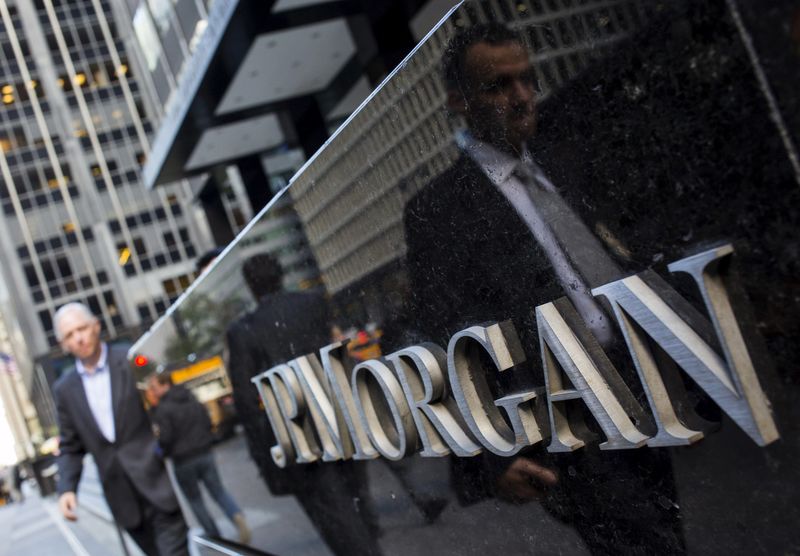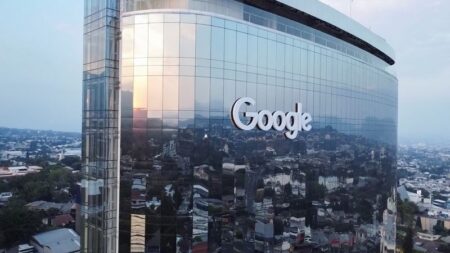JPMorgan Chase & Co. (JPM) has reported a robust financial performance for the second quarter of 2024, with a net income of $18.1 billion and earnings per share (EPS) of $6.12 on revenue of $51 billion. These figures include a substantial net gain from the sale of Visa (NYSE:) shares and a philanthropic contribution. Stripping out these one-time items, the adjusted net income stands at $13.1 billion, with an EPS of $4.40 and revenue at $43.1 billion.
The company’s Corporate and Investment Bank (CIB) and Consumer and Community Banking (CCB) segments showed strong performance, alongside a solid contribution from Asset and Wealth Management (AWM). JPMorgan also announced an increase in its quarterly dividend to $1.25 per share.
Key Takeaways
- JPMorgan Chase reported a net income of $18.1 billion for Q2 2024, including significant gains from Visa shares.
- Excluding one-time items, the net income was $13.1 billion with an EPS of $4.40.
- Investment banking fees surged by 50% year-over-year, with market revenue up by 10%.
- Record customer acquisition in Consumer and Community Banking and strong net inflows in Asset and Wealth Management.
- The company increased its quarterly dividend from $1.15 to $1.25 per share.
Company Outlook
- The company expects net interest income to face headwinds due to deposit balance pressures.
- JPMorgan is cautious about the IPO market and expects credit card charge-offs and delinquencies to normalize.
- ROTCE is anticipated to normalize around 17% due to various factors including NII normalization.
Bearish Highlights
- There are headwinds to deposit balances and potential upward pressure on charge-offs in the future.
- Loan demand outside of the Card business remains weak, with the company avoiding lending outside their risk appetite.
- The consensus provision for 2024 is considered slightly low, with an expected higher allowance build for the full year.
Bullish Highlights
- There was a record number of first-time investors in Consumer and Community Banking.
- Asset and Wealth Management saw strong growth in management fees and net inflows.
- The firm is generating significant organic capital, leading to a higher buyback percentage for the quarter.
Misses
- The IPO market has not been as robust as anticipated, with concerns over large industry performance and valuations.
- Non-interest-bearing deposits are expected to migrate into interest-bearing accounts, impacting the net interest margin.
Q&A Highlights
- Jeremy Barnum addressed the company’s performance, capital plans, and the impact of potential revisions to capital regulations.
- He discussed the progress in investment banking fees and the consumer credit environment.
- Barnum stated that it is too early to call an end to the normalization narrative and that the company is focused on managing the business.
JPMorgan’s financial report for Q2 2024 reflects a company that is navigating a complex economic environment with a disciplined approach. Despite some headwinds, the bank’s diversified business model and strategic capital management have contributed to a strong performance. As JPMorgan continues to monitor market conditions and adjusts its strategies accordingly, investors and stakeholders will be watching closely how these factors play out in the second half of the year.
InvestingPro Insights
JPMorgan Chase & Co. (JPM) stands out with its latest financial performance, and a deeper dive into the InvestingPro data and tips can provide further clarity for investors. The company’s market capitalization remains robust at $583.07 billion, reflecting its substantial presence in the financial industry. Additionally, JPMorgan’s price-to-earnings (P/E) ratio of 11.44, which adjusts to 10.66 on a last twelve months basis as of Q2 2024, indicates that the stock may be trading at a reasonable valuation relative to its near-term earnings growth. This aligns with one of the InvestingPro Tips, highlighting the company’s low P/E ratio in comparison to its earnings growth potential.
Investors seeking stability in dividend income might find JPMorgan particularly attractive, as the company has not only maintained but also raised its dividend payments for 54 consecutive years. The recent dividend increase to $1.25 per share is testament to this commitment, and with a dividend yield of 2.24% as of mid-2024, it stands as a solid choice for income-focused portfolios.
Revenue growth is another bright spot, with a substantial increase of 19.38% over the last twelve months as of Q2 2024. This growth is reflective of the strong performance across JPMorgan’s segments, particularly in the Corporate and Investment Bank (CIB) and Consumer and Community Banking (CCB).
For investors interested in further insights, there are several additional InvestingPro Tips available, which can be accessed through the dedicated InvestingPro page for JPMorgan at Utilize the coupon code PRONEWS24 to get up to 10% off a yearly Pro and a yearly or biyearly Pro+ subscription, unlocking a wealth of data and expert analysis to inform your investment decisions.
Full transcript – JP Morgan Chase (NYSE:) Q2 2024:
Operator: Good morning ladies and gentlemen. Welcome to JPMorgan Chase’s Second Quarter 2024 Earnings Call. This call is being recorded. Your line will be muted for the duration of the call. We will now go live to the presentation. The presentation is available on JPMorgan Chase’s website and please refer to the disclaimer in the back concerning forward-looking statements. Please stand by. At this time I would like to turn the call over to JPMorgan Chase’s Chief Financial Officer Jeremy Barnum. Mr. Barnum, please go ahead.
Jeremy Barnum: Thank you and good morning everyone. Starting on Page one, the firm reported net income of $18.1 billion, EPS of $6.12 on revenue of $51 billion with an ROTCE of 28%. These results included the $7.9 billion net gain related to Visa shares and the $1 billion foundation contribution of the appreciated Visa stock. Also included is $546 million of net investment securities losses in corporate. Excluding these items, the firm had net income of $13.1 billion, EPS of $4.40, and an ROTCE of 20%. Touching on a couple of highlights, in the CIB, IB fees were up 50% year-on-year and 17% quarter-on-quarter, and market revenue was up 10% year-on-year. In CCB, we had a record number of first-time investors and strong customer acquisition across checking accounts and card and we’ve continued to see strong net inflows across AWM. Now before I get more detail on the results I just want to mention that starting this quarter we are no longer explicitly calling out the First Republic contribution in the presentation. Going forward, we’ll only specifically call it out if it is a meaningful driver in the year-on-year comparison. As a reminder, we acquired First Republic in May of last year, so the prior year quarter only has two months of First Republic results compared to the full three months this quarter. Also in the prior year quarter most of the expenses were in corporate whereas now they are primarily in the relevant line-of-business. Now turning to Page 2 for the firm-wide results. The firm reported revenue of $51 billion, up $8.6 billion, or 20% year-on-year. Excluding both the Visa gain that I mentioned earlier, as well as last year’s First Republic bargain purchase gain of $2.7 billion, revenue of $43.1 billion was up $3.4 billion or 9%. NII ex-Markets was up $568 million or 3%, driven by the impact of balance sheet mix and higher rates, higher revolving balances in card, and the additional month of First Republic related NII, partially offset by deposit margin compression and lower deposit balances. NIR ex-Markets was up $7.3 billion or 56%. Excluding the items I just mentioned, it was up $2.1 billion or 21%, largely driven by higher investment banking revenue and asset management fees. Both periods included net investment securities losses. And markets revenue was up $731 million or 10% year-on-year. Expenses of $23.7 billion were up $2.9 billion or 14% year-on-year. Excluding the foundation contribution I previously mentioned, expenses were up 9% primarily driven by compensation including revenue related compensation and growth in employees. And credit costs were $3.1 billion reflecting net charge-offs of $2.2 billion and a net reserve build of $821 million. Net charge-offs were up $820 million year-on-year, predominantly driven by Card. The net reserve build included $609 million in consumer and $189 million in wholesale. Onto balance sheet and capital on Page 3. We ended the quarter with a CET1 ratio of 15.3% up 30 basis points versus the prior quarter, primarily driven by net income, largely offset by capital distributions and higher RWA. As you know, we completed CCAR a couple of weeks ago and have already disclosed a number of the key points. Let me summarize them again here. Our preliminary SCB is 3.3%, although the final SCB could be higher. The preliminary SCB, which is up from the current requirement of 2.9%, results in a 12.3% standardized CET1 ratio requirement, which goes into effect in the fourth quarter of 2024. And finally the firm announced that the Board intends to increase the quarterly common stock dividend from $1.15 to $1.25 per share in the third quarter of 2024. Now, let’s go to our businesses, starting with CCB on Page 4. CCB reported net income of $4.2 billion on revenue of $17.7 billion, which was up 3% year-on-year. In banking and wealth management, revenue was down 5% year-on-year, reflecting lower deposits and deposit margin compression, partially offset by growth and wealth management revenue. Average deposits were down 7% year-on-year and 1% quarter-on-quarter. Client investment assets were up 14% year-on-year, predominantly driven by market performance. In home lending, revenue of $1.3 billion was up 31% year-on-year, predominantly driven by higher NII, including one additional month of the First Republic portfolio. Turning to Card services and Auto, revenue was up 14% year-on-year, predominantly driven by higher Card NII and higher revolving balances. Card outstandings were up 12% due to strong account acquisition and the continued normalization of revolve. And in Auto, originations were $10.8 billion, down 10% coming off strong originations from a year ago, while continuing to maintain healthy margins. Expenses of $9.4 billion were up 13% year-on-year, predominantly driven by First Republic expenses now reflected in the lines-of-business, as I mentioned earlier, as well as field compensation and continued growth in technology and marketing. In terms of credit performance this quarter, credit costs were $2.6 billion reflecting net charge-offs of $2.1 billion up $813 million year-on-year, predominantly driven by Card, as newer vintages season and credit normalization continues. The net reserve build was $579 million, also driven by Card, due to loan growth and updates to certain macroeconomic variables. Next, the Commercial and Investment Bank on Page 5. Our new Commercial and Investment Bank reported net income of $5.9 billion on revenue of $17.9 billion. You’ll note that we are disclosing revenue by business, as well as breaking down the banking and payments revenue by client coverage segment in order to best highlight the relevant trends in both important dimensions of the wholesale franchise. This quarter, IB fees were up 50% year-on-year, and we Ranked Number #1 with year-to-date wallet share of 9.5%. And advisory, fees were up 45%, primarily driven by the closing of a few large deals in a week prior year quarter. Underwriting fees were up meaningfully with equity up 56% and debt up 51%, benefiting from favorable market conditions. In terms of the outlook, we’re pleased with both the year-on-year and sequential improvement in the quarter. We remain cautiously optimistic about the pipeline, although many of the same headwinds are still in effect. It’s also worth noting that pull-forward refinancing activity was a meaningful contributor to the strong performance in the first half of the year. Payments revenue was $4.5 billion, down 4% year-on-year, as deposit margin compression and higher deposit related client credits were largely offset by fee growth. Moving to markets, total revenue was $7.8 billion, up 10% year-on-year. Fixed income was up 5% with continued strength in securitized products. And equity markets was up 21%, with equity derivatives up on improved client activity. We saw record revenue in Prime on growth and client balances amid supportive equity market levels. Security services revenue of $1.3 billion was up 3% year-on-year, driven by higher volumes and market levels, largely offset by deposit margin compression. Expenses of $9.2 billion were up 12% year-on-year, largely driven by higher revenue related compensation, legal expense, and volume related non-compensation expense. In banking and payments, average loans were up 2% year-on-year due to the impact of the First Republic acquisition and flat sequentially. Demand for new loans remains muted as middle market and large corporate clients remain somewhat cautious due to the economic environment, and revolver utilization continues to be below pre-pandemic levels. Also, capital markets are open and are providing an alternative to traditional bank lending for these clients. In CRE, higher rates continue to suppress both loan origination and payoff activity. Average client deposits were up 2% year-on-year and relatively flat sequentially. Finally, credit costs were $384 million. The net reserve build of $220 million was primarily driven by incorporating the First Republic portfolio in the Firm’s modeled approach. Net charge-offs were $164 million, of which about half was in office. Then to complete our lines-of-business, AWM on Page 6. Asset and wealth management reported net income of $1.3 billion with pre-tax margin of 32%. Revenue of $5.3 billion was up 6% year-on-year, driven by growth in management fees on higher average market levels and strong net inflows, as well as higher brokerage activity, largely offset by deposit margin compression. Expenses of $3.5 billion were up 12% year-on-year, largely driven by higher compensation, primarily revenue-related compensation, and continued growth in our private banking advisor teams. For the quarter, long-term net inflows were $52 billion, led by equities and fixed income. And in liquidity, we saw net inflows of $16 billion. AUM of $3.7 trillion was up 15% year-on-year. And client assets of $5.4 trillion were up 18% year-on-year, driven by higher market levels and continued net inflows. And finally, loans and deposits were both flat quarter-on-quarter. Turning to corporate on Page 7. Corporate reported net income of $6.8 billion on revenue of $10.1 billion. Excluding this quarter’s Visa-related gain and the First Republic bargain purchase gain in the prior year, NIR was up approximately $450 million year-on-year. NII was up $626 million year-on-year, driven by the impact of balance sheet mix and higher rates. Expenses of $1.6 billion were up $427 million year-on-year, excluding foundation contribution expenses were down $573 million year-on-year, largely as a result of moving First Republic related expense out of corporate into the relevant segments. To finish up, we have the outlook on Page 8. Our 2024 guidance, including the drivers, remains unchanged from what we said at Investor Day. We continue to expect NII and NII ex-markets of approximately $91 billion, adjusted expense of about $92 billion, and on credit, Card net charge-off rate of approximately 3.4%. So to wrap up, the reported performance for the quarter was exceptional and actually represents record revenue and net income. But more importantly, after excluding the significant items, the underlying performance continues to be quite strong. And as always, we remain focused on continuing to execute with discipline. And with that, let’s open the line for Q&A.
Operator: For our first question, we’ll go to the line of Steven Chubak from Wolfe Research. Please go ahead.
Steven Chubak: Hi. Good morning, Jeremy.
Jeremy Barnum: Good morning Steve.
Steven Chubak: So, I wanted to start off with a question on capital. Just given some indications that the Fed is considering favorable revisions to both Basel III endgame and the GSIB surcharge calculations, which I know you’ve been pushing for some time. As you evaluate just different capital scenarios, are these revisions material enough where they could support a higher normalized ROTCE at the Firm versus a 17% target? And if so, just how that might impact or inform your appetite for buybacks going forward?
Jeremy Barnum: Right, okay. Thanks Steve. And actually before answering the question, I just want to remind everyone that Jamie is not able to join because he has a travel conflict overseas, so it’s just going to be me today. Okay. Good question on the capital and the ROTCE. So let me start with the ROTCE point first. In short, my answer to that question would be no. It’s hard to imagine a scenario coming out of the whole potential range of outcomes on capital that involves an upward revision on ROTCE. If you think about the way we’ve been talking about this, we’ve said that you know before the Basel III endgame proposal, we had a 17% through cycle target and that while you can imagine a range of different outcomes, the vast majority of them involve expansions of the denominator. And while we had ideas about changing the perimeter and repricing, all of which are still sort of in effect, most of those would be thought of as mitigants rather than things that would actually increase the ROTCE. And I don’t really think that answer has particularly changed. So as of now, that’s what I would say, which is a good pivot to the next point, which is yeah, we’ve been reading the same press coverage you’ve been reading and you know, it’s fun and interesting to speculate about the potential outcomes here, but in reality, we don’t know anything — you don’t know. We don’t know how reliable the press coverage is. And so in that sense, I feel like on the overall capital return and buyback trajectory, not much has actually changed relative to what I laid out at Investor Day, the comments that I made then, the comments that Jamie made then, as well as the comments that Jamie made subsequent week at an industry conference. So maybe I’ll just briefly summarize for everyone’s benefit what we think that is, which is one, we do recognize that our current practice on capital return and buybacks does lead to an ever-expanding CET1 ratio. But obviously we’re going to run the company over the cycle over time at a reasonable CET1 ratio with reasonable buffers relative to our requirements. So after all the uncertainty is sorted out, the question of the deployment of the Capital one way or another is a matter of when, not if. On the capital hierarchy, it’s also worth noting that’s another thing that remains unchanged, so I’ll review it quickly. You know, growing the business organically and inorganically, sustainable dividend, and in that context it’s worth noting that the Board’s announced intention to increase it to a $1.25 is a 19% increase prior to last year, so that’s a testament for our performance and that is a return of capital. And then finally buyback, but that hierarchy does not commit us to return 100% of the capital generation in any given quarter. And so, as we said here today, when you look at the relationship between the opportunity cost of not deploying the capital and the opportunities to deploy the capital outside the Firm, it is kind of hard to imagine an environment where that relationship argues more strongly for patients. So given all that, putting it all together I’m sorry for the long answer, we remain comfortable with the current amount of excess capital. And as Jamie has said, we really continue to think about it as earnings in store, as much as anything else.
Steven Chubak: No need to apologize, Jeremy. That was a really helpful perspective. Maybe just for my follow-up on NII. You’ve been very consistent just in flagging the risk related to NII over earning, especially in light of potential deposit attrition, as well as repricing headwinds. In the second quarter, we did see at least some moderation in repricing pressures. Deposit balances were also more resilient in what’s a seasonally weak quarter for deposit growth. So just given the evidence that some deposit pressures appear to be abating. Do you see the potential for NII normalizing higher? And where do you think that level could ultimately be in terms of stabilization?
Jeremy Barnum: Yes. Interesting question, Steve. So let’s talk about deposit balances. So yes I see your point about how balance pressures are slightly abating. When you look at the system as a whole, just to go through it, Q2 is still a bit of a headwind. Loan growth is modest and not enough to offset that. And RRP seems to have settled in roughly at its current levels, and there are reasons to believe that it might not go down that much more, although that could always change and that could supply extra reserves into the system. But on balance, net across all those various effects, we still think that there are net headwinds to deposit balances. So when we think of our balance outlook, we see it as flat to slightly down maybe, with our sort of market share and growth ambitions offsetting those system-wide headwinds. So in terms of normalizing higher, I guess it depends on relative to what. But I think it is definitely too early to be sort of calling the end of the over earning narrative or the normalization narrative. Clearly, the main difference in our current guidance relative to what we had earlier in the year, which implied a lot more sequential decline, is just the change in the Fed outlook. So two cuts versus six cuts is the main difference there. But obviously, based on the latest completion data and so on, you could usually get back to a situation with a lot more cuts in the yield curve. So we’ll see how it goes. And in the end, we are kind of focused on just running the place, recognizing and trying not to be distracted by what remains some amount of over earning, whatever it is.
Steven Chubak: Understood, Jeremy. Thanks so much for taking my questions.
Jeremy Barnum: Thanks Steve.
Operator: Next, we’ll go to the line of Saul Martinez from HSBC. Please go ahead.
Saul Martinez: Hi, good morning. Thanks for taking my question. Jeremy, can you give an update on the stress capital buffer? You noted, obviously, that you think there is an error in the Fed’s calculation due to OCI. Can you just give us a sense of what the dialogue with the Fed looks like? Is there a process to modify the SCB higher? And if you could give us a sense of what that process looks like.
Jeremy Barnum: Yes. So I’m not going to comment about any conversations with the Fed. Not to confirm or deny that they even exist, that stuff is private. And so — and then if you talk about like the timing here, right? So you know that the stress capital buffer that’s been released 3.3%, is a preliminary number. By rule, the Fed has to release that by August 31, it may come sooner. You talked about an error in the calculation, we haven’t used that word. What we know — what we believe, rather, is that the amount of OCI gain that came through the Fed’s disclosed results looked non-intuitively high to us. And if you adjust that in ways that we think are reasonable, you would get a slightly higher stress capital buffer. Whether the Fed agrees and whether they decide to make that change or not is up to them, and we’ll see what happens. I think the larger point is that if you look at the industry as a whole and if you sort of put us into that with some higher pro forma SCB, whatever it might conceivably be, you actually see once again, quite a bit of volatility in the year-on-year change in the stress capital buffer for many firms. And just sort of reiterating and — another example of what we’ve said a lot over the years, that it’s volatile, it’s untransparent, it makes it very hard to manage capital of a bank. It leads to excessively high management buffers, and we think it’s really not a great way to do things. So I’ll leave it at that.
Saul Martinez: Okay. Got it. That’s helpful. Just following up on capital returns on Steve’s question. I think you highlighted in response as a matter of when not if. And obviously, Jamie is not there. You can’t speak for Jamie. But seems to have shown limited enthusiasm for a special dividend or buybacks at current valuations. Can you just give us a sense of how you’re thinking about the various options? Any updated thoughts on your special dividend? And can you do other things like for example, have a material increase in your dividend payout sort of a step function increase, where — keep that flat and grow into that grow your earnings into that over time? Can you just maybe give us a sense of how you’re thinking about what options you have available to deploy that capital.
Jeremy Barnum: Yes. I mean I would direct you to read — actually, I have Jamie’s comments at the industry conference where you participated the week after Investor Day, because he wanted just a good amount of detail on this stuff addressing some of these points. And I think his comment there about the special dividend was that it’s not really a preference. We hear from people that many of our investors wouldn’t find that particularly appealing, and he said as much that it wouldn’t be sort of our first choice. So I think the larger point is just that — a little bit to your question, there are a number of tools in the toolkit, and they’re really the same tools that are part of our capital hierarchy. So first and foremost, we’re looking to deploy the capital into organic or inorganic growth. And then the dividend, I think, we are always going to want to keep it in that like sustainable, and also sustainable in a stress environment. So that continues to be the way we think about that. And then at the end of it, it is buybacks. And Jamie has been on the record for over a decade, I think over many shareholder letters, talking about how he thinks about price and buybacks and valuation, and price is a factor. So that’s sort of the totality of the sort of options, I guess.
Saul Martinez: Okay, great. Thanks a lot.
Jeremy Barnum: Thanks Saul.
Operator: Next, we’ll go to the line of Ken Usdin from Jefferies. Please go ahead.
Ken Usdin: Thanks a lot. Good morning Jeremy. Jeremy, great to see the progress on investment banking fees, up sequentially and 50% year-over-year. And I saw you on the tape earlier just talking about still regulatory concerns a little bit in the advisory space. And we clearly didn’t see the debt pull-forward play through, because DCM was great again. I’m just wondering just where you feel the environment is relative to the potential. And just where the dialogue is across the three main bucket areas in terms of like how does this feel in terms of current environment versus a potential environment that we could still see ahead? Thanks.
Jeremy Barnum: Yes. Thanks, Ken. It’s progress, right? I mean we are happy to see the progress. People have been talking about [depressed] (ph) banking fee wallet for some time, and it’s nice to see not only the year-on-year pop on the low base, but also a nice sequential improvement. So that’s the first thing to say. In terms of dialogue and engagement, it’s definitely elevated. So as the dialogue on ECM is elevated and the dialogue on M&A is quite robust as well. So all of those are good things that encourage us and make us hopeful that we could be seeing sort of a better trend in this space. But there are some important caveats. So on the DCM side, yes, we made pull-forward comments in the first quarter, but we still feel that this second quarter still reflects a bunch of pull forward, and therefore we are reasonably cautious about the second half of the year. Importantly, a lot of the activity is refinancing activity as opposed to for example, acquisition finance. So the fact that M&A remains still relatively muted in terms of actual deals has knock-on effects on DCM as well. And when a higher percentage of the wallet is refi, then the pull-forward risk becomes a little bit higher. On ECM, if you look at it kind of at [remove] (ph), you might ask the question, given the performance of the overall indices, you would think it would be a really booming environment for IPOs, for example. And while it’s improving, it’s not quite as good as you would otherwise expect. And that’s driven by a variety of factors, including the fact that as has been widely discussed, that extent to which the performance of the large industries is driven by like a few stocks, the sort of mid-cap tech growth space and other spaces that would typically be driving IPOs have had much more muted performance. Also, a lot of the private capital that was raised a couple of years ago was raised at pretty high valuations. And so in some cases, people looking at IPOs could be looking at down rounds, that’s an issue. And while secondary market performance of IPOs has improved meaningfully, in some cases, people still have concerns about that. So those are a little bit of overhang on that space. I think we can hope that, over time that fades away and the trend gets a bit more robust. And yes, on the advisory side, the regulatory overhang is there, remains there. And so we’ll just have to see how that plays out.
Ken Usdin: Great. Thank you for all that Jeremy. And just one on the consumer side. Just anything you’re noticing in terms of people who just have been waiting for this delinquency stabilization on the credit card side. Obviously, your loss rates are coming in as you expected, and we did see 30 days pretty flat and 90 days come down a little bit. Any — is that seasonal? Is it just a good rate of change trend? Any thoughts there? Thanks.
Jeremy Barnum: Yes. I still feel like when it comes to Card charge-offs and delinquencies, there’s just not much to see there. It’s still — it’s normalization, not deterioration. It’s in-line with expectations. As I say, we always look quite closely inside the cohort, inside the income cohorts. And when you look in there, specifically, for example on spend patterns, you can see a little bit of evidence of behavior that’s consistent with a little bit of weakness in the lower income segments, where you see a little bit of rotation of the spend out of discretionary into non-discretionary. But the effects are really quite subtle, and in my mind definitely entirely consistent with the type of economic environment that we are seeing, which, while very strong and certainly a lot stronger than anyone would have thought given the tightness of monetary conditions, say, like they’ve been predicting it a couple of years ago or whatever, you are seeing slightly higher unemployment, you are seeing moderating GDP growth. And so it is not entirely surprising that you’re seeing a tiny bit of weakness in some pockets of spend. So it all kind of hangs together in what is sometimes actually not a very interesting story.
Ken Usdin: Thank you.
Jeremy Barnum: Thanks Ken.
Operator: Next, we’ll go to the line of Glenn Schorr from Evercore ISI. Please go ahead.
Glenn Schorr: Hi, thanks very much. So Jeremy, the discussions so far around private credit and you all, your recent comments have been the ability to add on balance sheet and compete when you need to compete on the private credit front. I do think that most of the discussion has been about the direct-lending component. So I’m curious if you are showing more progress and activity on that front. And then very importantly, do you see the same trend happening on the asset-backed finance side, because that’s a bigger part of the world, and it is a bigger part of your business? So I’d appreciate your thoughts there. Thanks.
Jeremy Barnum: Yes. Thanks, Glenn. So on private credit, so nothing really new to say there. I think — I guess one way the environment is evolving a little bit is that as you know, a lot of money has been raised in private credit funds looking for deals. And sort of a little bit to my prior comment, in a relatively muted acquisition finance environment, at this point you’ve got a lot of money chasing kind of like not that many deals. So the space is a little bit quieter than it was at the margin. Another interesting thing to note is some of this discussion about kind of lender protections that were typical in the syndicated lender finance market making their way into the private market as well, is sort of people realize that even in the private market, you probably need some of those protections in some cases. Which is sort of supportive of the theme that we’ve been talking about, about convergence between the direct lending space and the syndicated lending space, which is kind of our core thesis here, which is that we can offer best-in-class service across the entire continuum, including secondary market trading and so on. So we feel optimistic about our offering there. I think the current environment is maybe a little bit quieter than it was. So it is maybe not a great moment to like kind of test whether we are doing a lot more or less in the space, so to speak. And then on asset-backed financing, you actually asked me that question before. And at the time, my answer was that I haven’t heard much about that trend, and that continues to be the case. But clearly, there must be something I’m missing. So I can follow up on that and maybe we can have a chat about it.
Glenn Schorr: That’s great for you if you are not hearing much about it, so we can leave it at that. Maybe just one quick follow-up in terms of your just overall posturing on — you were patient and smart when rates were low, waited to deploy, worked out great. We know that story. Now it seems like you have tons of excess liquidity and you are being patient and rates are high. And I’m curious on how you think about what kind of triggers, what kind of things you’re looking for in the market to know if and when you would extend duration?
Jeremy Barnum: Right. I mean on duration, in truth we have actually added a little bit of duration over the last couple of quarters. So that’s one thing to say, that was more last quarter than this quarter. But I guess I would just caution you from — a little bit away from looking at kind of our reported cash balances and our balance sheet, and concluding that when you look at the duration concept holistically, that there is a lot to be done differently on the duration front. So clearly, it is true that empirically, we’ve behaved like very asset sensitively in this rate hiking cycle, and that has resulted in a lot of excess NII generation sort of on the way up in the near-term. But when we look at the fund’s overall sensitivity to rates, we look at it through both like the [EAR type lens] (ph), the short-term NIR sensitivity, but also a variety of other lenses, including various types of scenario analysis, including impacts on capital from higher rates. And as I think Jamie has said a couple of times, we actually aim to be relatively balanced on that front. Also, given like the inverted yield curve, it’s not as if extending duration from these levels means that you’re walking in 5.5% rate. In fact, the forwards are not sort of that compelling given our views about some sort of structural upward pressures on inflation and so on. So I think when you put that all together, I don’t think that kind of a big change in duration posture is a thing that’s front in mind for us.
Glenn Schorr: Super, helpful. Thanks so much for that.
Jeremy Barnum: Thanks Glenn.
Operator: Next, we’ll go to the line of Matt O’Connor from Deutsche Bank. Please go ahead.
Matt O’Connor: Good morning. I was just wondering if you can elaborate on essentially the math behind the ROTCE being too high at 20% and normalized at 17%. Obviously, you’ve pointed to over-[earning NII] (ph). And I guess the question is, is that all of it to go from 20% to 17%? And if so, is that all consumer deposit costs? Or are there a few other components that you could help frame for us?
Jeremy Barnum: Sure. Good question, Matt. I mean, I guess the way I think about it is a couple of things. Like our returns tend to be a bit seasonal, right? So if you kind of build yourself out a full year forecast and make reasonable space on your own, or analyst consensus or whatever, and you think about the fourth quarter, better look at this on a full year basis when you think about the returns than the quarterly numbers, and you obviously have to strip out kind of the onetime items. And so if you do that, like whatever you get for this year is still clearly a number that’s higher than 17%. So yes, one source of headwinds is normalization of the NII, primarily as a result of the expected higher deposit costs. That’s — we’ve talked about that. Part of it is also the yield curve effects. Some cuts will come into the curve at some point. And in the normal course, if you kind of do a very, very, very supplemental model of the company, you would have like expenses grow — revenue is growing at some organic GDP like rate, maybe higher, and expenses growing at a similar slightly lower rate, producing a sort of relatively stable overhead ratio. But even if the amount of NII normalization winds up being less than we might have thought at some prior point, you still have some background — you still have some normalization of the overhead ratio that needs to happen. So as much as our discipline on expense management is, as tight as it always has been, the inflation is still non-zero. There are still investments that we’re executing. There is still higher expense to come in a slightly flatter revenue environment as a result of in part, the normalization of NII. And then the final point is that whatever winds up being the answer on Basel III endgame and all the other pieces, you have to assume some amount of expansion of the denominator, at least based on what we know so far. So of course, any of those pieces could be wrong, but that’s kind of how we get to our 17%. And if you look at the various scenarios that we showed on the last page of my Investor Day presentation, it illustrates those dynamics and also how much the range could actually vary as a function of the economic environment and other factors.
Matt O’Connor: Yes. That was a really helpful chart. Just one follow-up. On the yield curve effects, I guess, what do you mean by that? Because right now, the yield curve is inverted, maybe you’re still leaving any impact of that. But kind of longer-term, you’d expect a little bit of steepness of the curve, which I would think would help. But what does you mean by that? Thank you.
Jeremy Barnum: Yes. I mean you and I talked about this before. I guess I sort of — I guess I don’t really agree fundamentally with the notion that the way to think about things is that sort of yield curve steepness above and beyond what’s priced in by the forwards is a source of structural NII or NIM for banks, if you know what I mean. Like I mean people have different views about the so-called term premium. And obviously, in a moment of inverted curve and different types of treasury supply dynamics, people thinking on that may be changing. But I think we saw, when rates were at Zero and the 10-year note was below 2%, everyone sort of — many people were kind of tempted to try to get extra NIM and extra NII by extending duration a lot. But when the steepness of the curve implies — is driven by the expectation of actually aggressive Fed tightening, it’s just a timing issue and you can wind up kind of pretty offside from the capital and other perspectives. So there are some interesting questions about whether fiscal dynamics might result in a structurally steeper yield curve down the road and whether that could be sort of — earning the term premium, so to speak, could be a source of NII, but that feels a bit speculative to me at this point.
Matt O’Connor: Got it. Okay, thank you for the details.
Jeremy Barnum: Thanks Matt.
Operator: Next, we’ll go to the line of Mike Mayo from Wells Fargo Securities. Please go ahead.
Mike Mayo: Hi. Jeremy, you said it’s too early to end the over earning narrative, and you highlighted higher deposit costs and the impact of lower rates and lower NII and DCM pull-forward and credit cost going higher. Anything I’m missing on that list? And what would cause you to end the over earning narrative?
Jeremy Barnum: No. Actually, I think that is the right list Mike. I mean, frankly, I think one thing that would end to be over earning narrative is if our annual returns were closer to 17%. I mean to the extent that, that is the through-the-cycle number that we believe and that we are currently producing more than that, that’s one very simple way to look at that. But the pieces of that or the pieces that you talked about and the single most important piece is the deposit margin. Our deposit margins are well above historical norms, and that is a big part of the reason that we still are emphasizing the over earning narrative.
Mike Mayo: You’re 17% through-the-cycle ROTCE kind of expectation, what is the CET1 ratio that you assumed for that?
Jeremy Barnum: I mean we would generally assume requirements plus a reasonable buffer, which depending on the shape of rules, could be a little bit smaller or a little bit bigger. And the small part as a function of the volatility of those pools, which goes back to my prior comments on SCB and CCAR. But obviously, as you well know, what actually matters is less the ratio and more of the dollars. And at this point, the dollars are very much a function of where rules land and where the RWA lands, and obviously things like GSIB recalibration and so on. So we’ve done a bunch of scenario analysis along the lines of what I did at Investor Day that informs those numbers, but that is obviously one big element of uncertainty behind that 17%. Which is why at Investor Day, when we talked about it, both Daniel and I were quite specific about saying that we thought 17% was still achievable, assuming a reasonable outcome on the Basel III endgame.
Mike Mayo: Let me just zoom out for one more question on the return target. I mean when I asked Jamie at the [2013] (ph) Investor Day would it make sense to have 13.5% capital, he was basically telling you take a hike, right? And now you have 15.3% capital and you’re saying, well, we might want to have a lot more capital here. I mean at some point, if you’re spending $17 billion a year to improve the company, if you’re gaining share with digital banking, if you’re automating the back office, if you’re moving ahead with AI, if you’re doing all these things that I think you say others aren’t doing, why wouldn’t those returns go higher over time? Or do you just assume you’ll be competing those benefits away? Thanks.
Jeremy Barnum: Yes. I mean, I think in short, Mike, and we’ve talked about this a lot and Jamie has talked about this a lot, it is a very, very, very competitive market. And we are very happy with our performance. We are very happy with the share we’ve taken. And 17% is like an amazing number actually. And like to be able to do that, given how robust the competition is from banks, from non-banks, from US banks, from foreign banks and all of the different businesses that we compete in, is something that we’re really proud of. So the number has a range around it, obviously. So it’s not a promise, it’s not a guarantee and it can fluctuate. But we are very proud to be in the ballpark of being able to think that we can deliver it, again assuming a reasonable outcome on Basel III endgame. But it’s a very, very, very competitive market across all of our products and services and regions and [line] (ph) segments.
Mike Mayo: All right. Thank you.
Operator: Next, we’ll go to the line of Betsy Graseck from Morgan Stanley. Please go ahead.
Betsy Graseck: Hi, Jeremy.
Jeremy Barnum: Hi, Betsy.
Betsy Graseck: So I did want to ask one drill-down question on 2Q, and it is related to the dollar amount of buybacks that you did do. I think in the press release, right and the slide deck, it’s $4.9 billion common stock net repurchases. So the question here is what’s the governor for you on how much to do every quarter? And I mean I understand it is a function of okay, how much do we organically grow. But even with that, so you get the organic growth which you had some nice movement there. But you do the organic growth and then is it how much do we earn and we want to buy back our earnings? Or how should we be thinking about what that repurchase volume should be looking like over time? And I remember at Investor Day, the whole debate around I don’t want to buy back my stock, but we are right? So I get this question from investors quite a bit of how should we be thinking about how you think about what the right amount is to be doing here?
Jeremy Barnum: Yes. That’s a very good and fair question, Betsy. So let me try to unpack it to the best of my abilities. So — in no particular order. One thing that we’ve really tried to emphasize in a number of different settings, including in our recent 10-Qs actually, is that we don’t want to get into the business of guiding on buybacks. So we’re going to buy back whatever we think makes sense in the current moment sort of — and we prefer the right to sort of change that at any time. So I recognize that not everyone loves that, but that is kind of a philosophical belief. And so I might as well say it explicitly. It was pretty clear in the [Q] (ph) also, but I’m just going to say that again. So that’s point one. But having said that, let me nonetheless try to address your point on framework and governors. So generally speaking, we think it doesn’t make sense to sort of exit the market entirely unless the conditions are much more unusual than they are right now, let’s say. Obviously, when for whatever reason, if we ever need to build capital in a hurry, we’ve done it before and we are always comfortable suspending buybacks entirely. But I think some modest amount of buybacks, is a reasonable thing to do when you are generating your kind of capital. And so we were talking before about this $2 billion pace, we’re kind of trying to move away from this notion of a pace, but that’s where that idea comes from, let’s put it that way. You talked about the $4.9 million, which I recognize may seem like a little bit of a random number. But where that actually comes from is the other statement that we made, that we have these significant item gains from Visa. And if you think about what that means, it means that we have, post the acceptance of the exchange offer, a meaningful long position and liquid large cap financial stock, i.e. Visa, which realistically is highly correlated to our own stock. And so in some sense, why carry that instead of just buying back JPMorgan stock. So we talked about, Jamie talked about as we liquidate the Visa, deploying those proceeds into JPM, and that’s what we did this quarter. So that is why the 4.9% is a little higher. And it’s consistent with my comments at our Investor Day around having slightly increased the amount of buybacks. And beyond that what you are left with is answer to Steve’s question, which is that, to your point about buying back earnings or whatever, when we are generating these types of earnings and there is this much organic capital being generated, in the absence of opportunities to deploy it organically or inorganically and while continuing to maintain our healthy but sustainable dividend, if we don’t return the capital, we are going to keep growing the CET1 ratio, the levels of which — if you think about the long strategic outlook of the company, are not reasonable. They’re just artificially high and unnecessary. So one way or the other, that will need to be addressed at some point. It’s just that we don’t feel now is the right time.
Betsy Graseck: Great. Thank you Jeremy. Appreciate it.
Jeremy Barnum: Thanks Betsy.
Operator: Next, we’ll go to the line of Gerard Cassidy from RBC Capital Markets. Please go ahead.
Gerard Cassidy: Hi, Jeremy, how are you?
Jeremy Barnum: Hi, Gerard.
Gerard Cassidy: Jeremy, can you — I know you touched on deposits earlier in the call in response to a question. I noticed on the average balances, the non-interest bearing deposits were relatively stable quarter-to-quarter versus prior quarters when they have steadily declined. And this is one of the areas, of course investors are focused on in terms of the future of the net interest margin for you and your peers. Can you elaborate, if you can, what you’re seeing in that non-interest-bearing deposit account? I know this is average and not period end, the period end number may actually be lower. But what are you guys seeing here?
Jeremy Barnum: Yes. Good question, Gerard. I have to be honest, I haven’t focused on that particular sequential explain i.e., quarter-on-quarter change and average non-interest-bearing deposits. But I think the more important question is the big picture question, which is what do we expect? I mean how are we thinking about ongoing migration of non-interest-bearing into interest-bearing in the current environment, and how that affects our NII outlook and our expectation for weighted average rate paid on deposits. And the answer to that question is that we do continue to expect that migration to happen. So if you think about it in the wholesale space, you have a bunch of clients with some balances in non-interest-bearing accounts, and over time for a variety of reasons, we do see them moving those balances into interest-bearing. So we do continue to expect that migration to happen, and therefore, that will be a source of headwinds. And that migration sometimes happens internally, i.e., out of non-interest-bearing into interest-bearing or into CDs. Sometimes it goes into money markets or into investments, which is what we see happening in our Wealth Management business. And some of it does leave the company. But one of the things that we are encouraged by is the extent to which we are actually capturing a large portion of that yield-seeking flow through CDs and money market offerings, et cetera, across our various franchises. So big picture. I do think that migration out of non-interest-bearing into interest-bearing will continue to be a thing, and that is a contributor to the modest headwinds that we expect for NII right now. But yes I’ll leave it at that, I guess.
Gerard Cassidy: Very good. And as a follow-up, you’ve been very clear about the consumer credit card charge-offs and delinquency levels. And we all know about the commercial real estate office, and you always talk about over-earning on net interest income of course. One of the great credit quality stories for everyone, including yourselves, is the C&I portfolio, how strong it’s been for — in this elevated rate environment. And I know your numbers are still quite low, but in the Corporate and Investment Bank, you had about a $500 million pickup in non-accrual loans. Can you share with us what are you seeing in C&I? Are there any signs of cracks or anything? And again, I know your numbers are still good, but I’m just trying to look forward to see if there’s something here over the next 12 months or so.
Jeremy Barnum: Yes, it’s a good question. I think the short answer is no, we are not really seeing early signs of cracks in C&I. I mean, yes, I agree with you, like the C&I charge-off rate has been very, very low for a long time. I think we emphasized that at last year’s Investor Day, if I remember correctly. I think the C&I charge-off rate we are seeing 10 years was something like literally zero. So that is clearly very low by historical standards. And while we take a lot of pride in that number, I think it reflects the discipline in our underwriting process and the strength of our credit culture across bankers and the risk team, that’s not — we don’t actually run that franchise to like a zero loss expectation. So you have to assume there will be some upward pressure on that. But in any given quarter, the C&I numbers tend to be quite lumpy and quite idiosyncratic. So I don’t think, that anything in the current quarter results is indicative of anything broader, and I haven’t heard anyone internally talk that way, I would say.
Gerard Cassidy: Great, appreciate the insights as always. Thank you.
Jeremy Barnum: Thanks Gerard.
Operator: Next, we’ll go to the line of Erika Najarian from UBS. Please go ahead.
Erika Najarian: Hi, good morning. I just had one cleanup question, Jeremy. The consensus provision for 2024 is $10.7 billion. Could you maybe clarify for once and for all sort of Jamie’s comments at an industry conference earlier and try to sort of triangulate if that $10.7 billion provision is appropriate for the growth level that you are planning for in Card?
Jeremy Barnum: Yes. Happy to clarify that. So Jamie’s comments were that the allowance to build and the Card allowance, so we are talking about Card specifically, we expected something like $2 billion for the full year. As I sit here today, our expectation for that number is actually slightly higher, but it is in the ballpark. And I think in terms of what that means for the consensus on the overall allowance change for the year, last time I checked, it still looked a little low on that front. So who knows what it will actually wind up being, but that remains our view. One question that we’ve gotten is how to reconcile that build to the 12% growth in OS that we’ve talked about because it seems like a little bit high relative to what you would have otherwise assumed if you apply some sort of a standard coverage ratio to that growth. But the reason that’s the case is essentially a combination of higher revolving mix as we continue to see some normalization revolve in that 12%, as well as seasoning of earlier vintages, which comes with slightly higher allowance per unit of OS growth.
Erika Najarian: Great. Thank you.
Jeremy Barnum: Thanks Erika.
Operator: And for our final question, we’ll go to the line of Jim Mitchell from Seaport Global Securities. Please go ahead.
Jim Mitchell: Hi, good morning. Maybe just one last question on sort of deploying excess capital. It seems like the two primary ways to do that organically would be through the trading book or the loan book. So maybe two questions there. One, trading assets were up 20% year-over-year. Is that you leaning into it or just a function of demand? And is there further opportunities to grow that? And then secondly outside of Cards, loan demand has been quite weak. And any thoughts from you on if you’re seeing any change in demand or how you’re thinking about loan demand going forward? Thanks.
Jeremy Barnum: Thanks, Jim. Good question. So yes, trading assets have been up. That is basically client activity primarily secured financing related sort of matchbook repo type stuff and similar things that are — grows up the balance sheet quite a bit, but are quite low risk and therefore quite low RWA intensity. So while our ability the supply that financing to clients is something that we’re happy about and it’s very much represents us leaning into the franchise to serve our clients. It’s not really particularly RWA, and therefore capital intensive, and therefore it doesn’t really reflect an aggressive choice on our part to deploy capital, so to speak. On the loan demand front, yes, I mean, unfortunately, I just don’t have much new to say there on loan demand. Meaning, to your point, loan demand remains quite muted everywhere except Card. Our Card business is, of course, in no way capital constrained. So whatever growth makes sense there in terms of our customer franchise and our ability to acquire accounts and retain accounts, and what fits inside our credit risk appetite is growth that’s going to make sense. And so we’re very happy to deploy capital to that. But it’s not constrained by our willingness or ability to deploy capital to that. And of course, for the rest of the loan space, the last thing that we are going to do is have the excess capital mean that we lean in to lending that is not inside our risk appetite or inside our credit box, especially in a world where spreads are quite compressed and terms are under pressure. So there is always a balance between capital deployment and assessing economic risk rationally. And frankly, that is in some sense, a microcosm of the larger challenge that we have right now. When I talked about if there was ever a moment where the opportunity cost of not deploying the capital relative to how attractive the opportunities outside the walls of the company are, now would be it in terms of being patient. That’s a little bit one example of what I was referring to.
Jim Mitchell: All right. Okay, great. Thanks.
Jeremy Barnum: Thanks Jim.
Operator: And we have no further questions.
Jeremy Barnum: Very good. Thank you, everyone. See you next quarter.
Operator: Thank you all for participating in today’s conference. You may disconnect your line and enjoy the rest of your day.
This article was generated with the support of AI and reviewed by an editor. For more information see our T&C.
Read the full article here
















